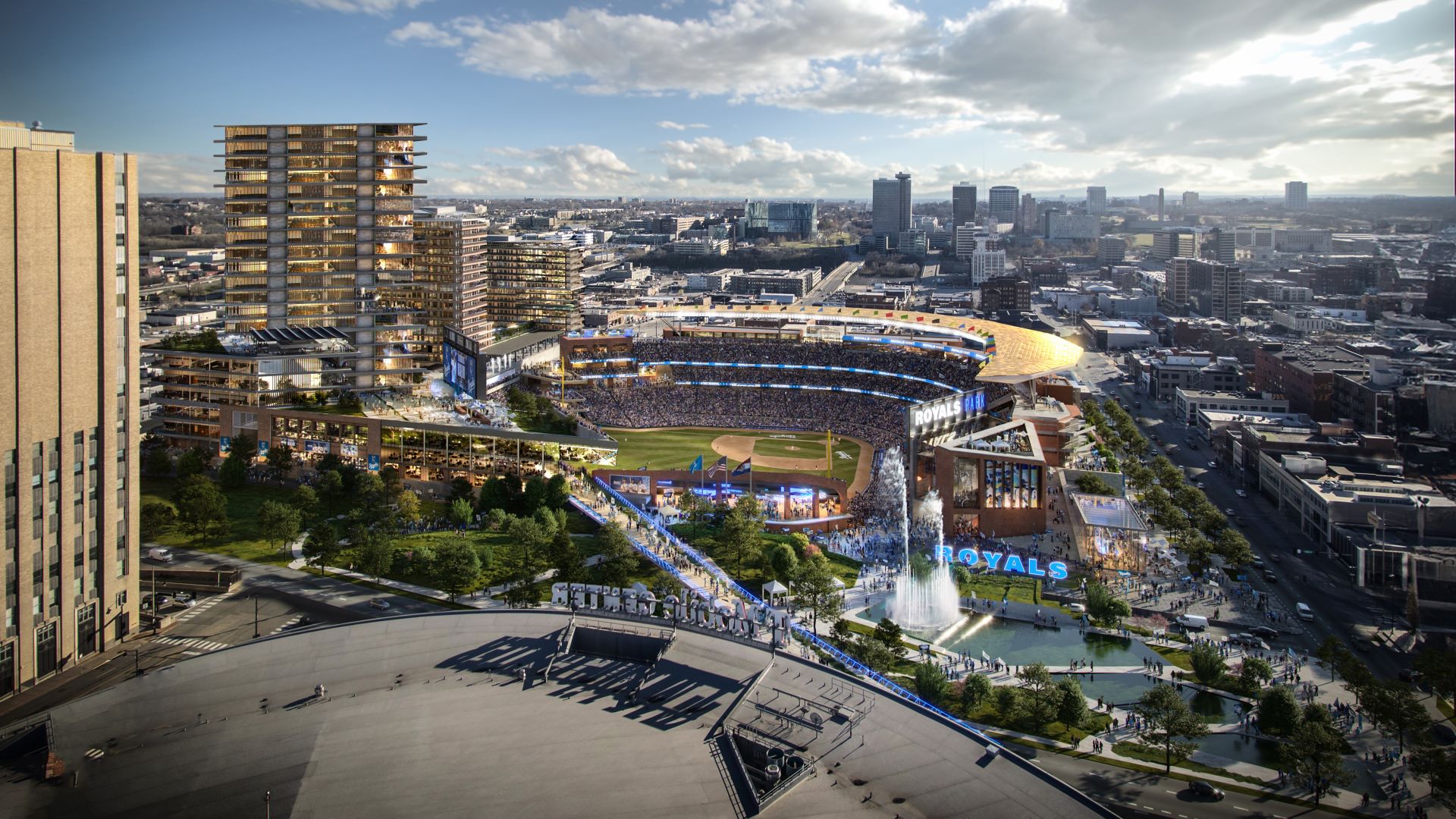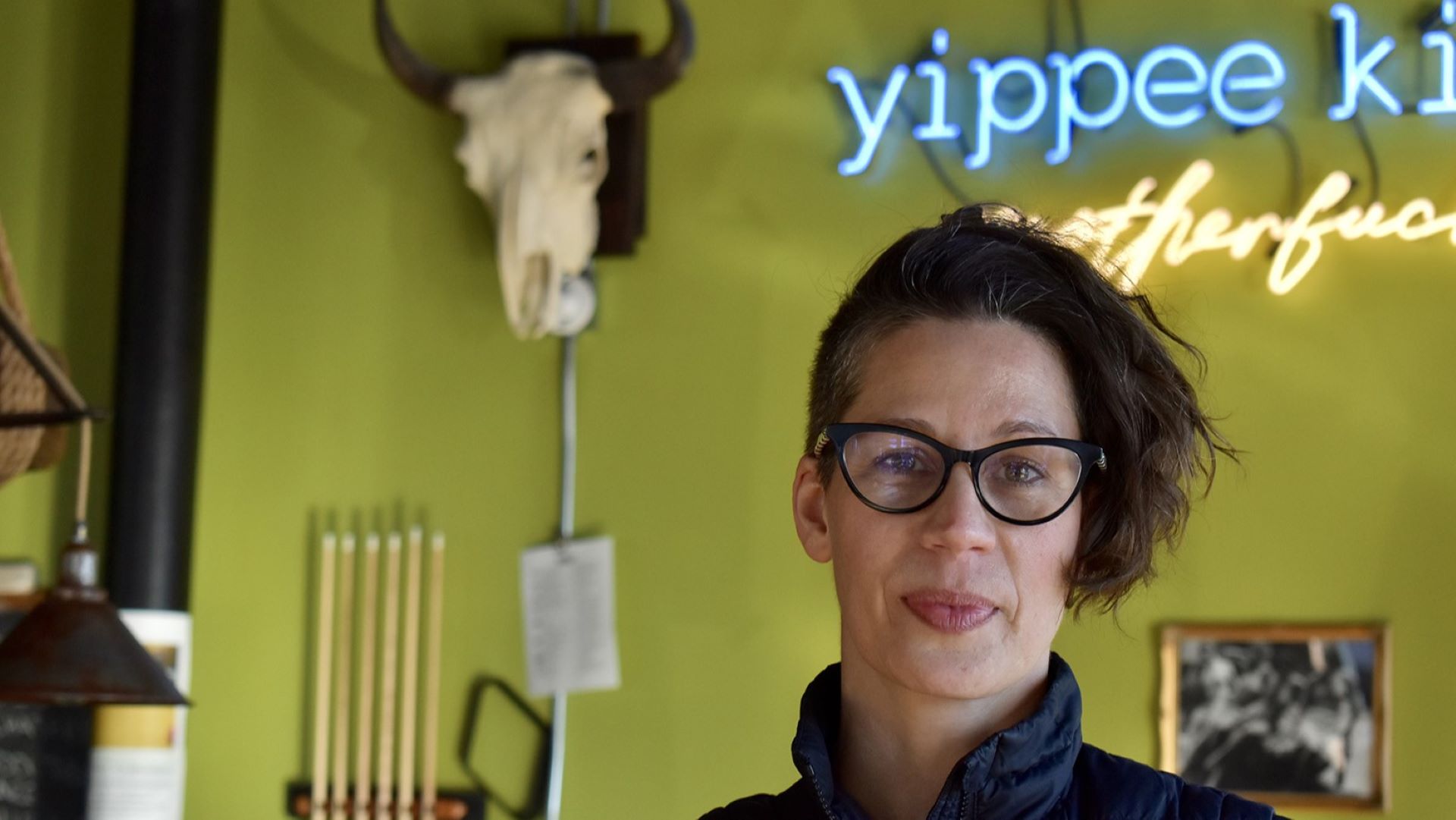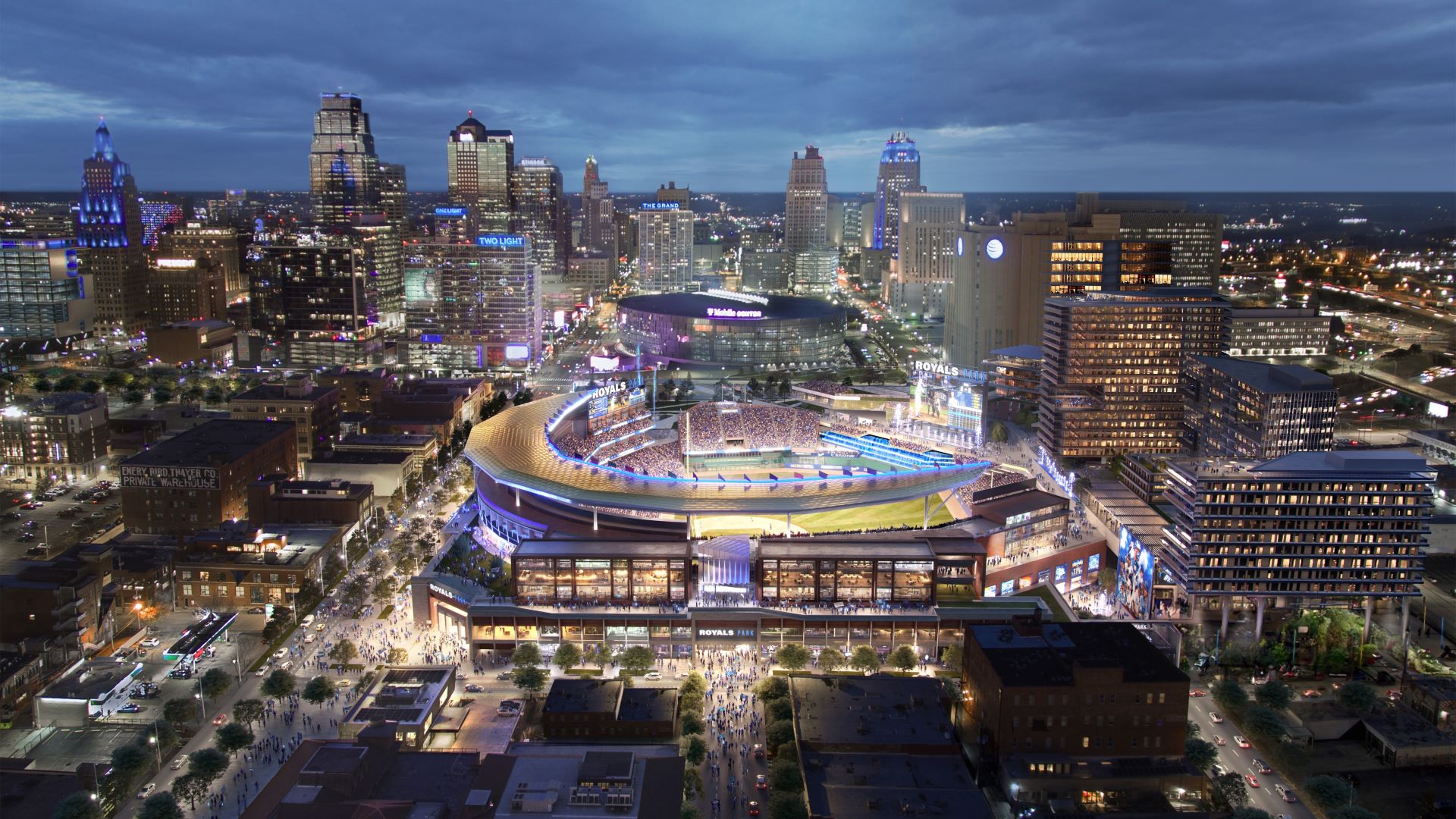Kansas City Royals Ballpark Plan Sparks Parking Debate Changing Mindsets Around a 'Huge Issue'
Published March 27th, 2024 at 6:00 AM
Above image credit: Cars lined streets in a portion of the East Crossroads on Saturday night (March 23), an example of the dearth of available parking spots currently on some busy weekend nights. (Mary Sanchez | Flatland)Here’s the essential message that the Kansas City Royals have for folks fretting about parking downtown if a new ballpark is built in the Crossroads.
Relax.
A presentation released last week by the design team at Populous and traffic consultant Kimley-Horn contends that downtown’s existing 40,000 parking spaces will be able to accommodate fans for a downtown baseball game.
The report notes that there are nearly 19,000 parking spaces – excluding streetside parking that would be reserved for nearby businesses – within a 10-minute walk of the proposed ballpark in the Crossroads.
The report assumes that peak gameday demand for parking would be about 9,000 spaces, including 1,500 new on-site spaces that would be developed as part of the ballpark project. It assumes that 70% of fans would arrive by private vehicle, while the rest would travel by foot, bike, bus, streetcar or ride share.
“The Greater Downtown area has abundant parking and the necessary infrastructure in place to handle baseball games,” concludes the 14-page presentation. “No new offsite parking is required to support the ballpark…”
The team contends that will remain true even when there are “overlapping events” at T-Mobile Center, the Kauffman Center for the Performing Arts, Bartle Hall and even First Fridays in the Crossroads.
There’s just one problem. Many folks aren’t buying it.
Check the Map
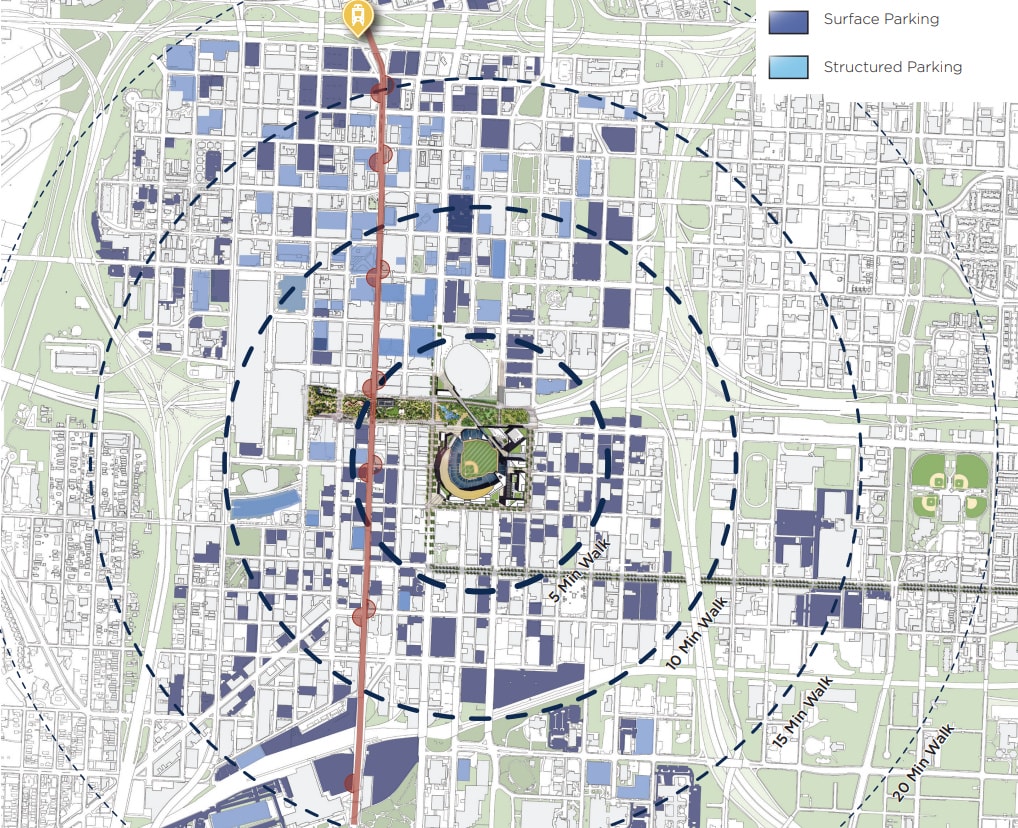
‘It’s a Huge Issue’
Concerns about parking, and related traffic congestion, have been a constant worry of some opposed to building a ballpark in the Crossroads.
“It’s a huge issue,” said Becky Nace, a former member of the Kansas City Council and chair of the Committee Against New Royals Stadium Taxes. “Their attempts to minimize (parking) falls on deaf ears because we have all gone down there for other events and have experienced the parking issue.”
Possibly worse, some of the people whose job it is to manage getting thousands of Kansas Citians parked at concert halls, arenas and office spaces downtown weren’t aware of the specifics of the team’s parking and traffic plan.
They weren’t consulted before the team’s report was released, several said, although they also did not want to be quoted about their concerns.
For now, many are holding their breath.
They’re waiting to see if Jackson County voters will approve a 3/8-cent sales tax to help fund a new stadium in the Crossroads Arts District. If the tax passes on April 2, then conversations about parking will likely begin in earnest.
For now, the assessment is happening offline.
But many question how a 34,000-capacity ballpark will fit into current parking scenarios, knowing that convenient open slots are often at a premium during busy evenings, especially on weekends when there are large events in town.
Consider that patrons have been encouraged in recent seasons to buy their parking ticket ahead of time and to allow more time than in previous years to arrive for some events at the Kauffman Center and Bartle Hall.
One reason is the growing vitality of downtown.
“We’re having a conversation about parking downtown when I remember about 25 years ago, we had a conversation about how there was nobody downtown,” said Sly James, a former mayor of Kansas City and a consultant for the stadium sales tax campaign. “Things change.”
The Stadium Tax Debate
One example of change is that more people now realize that the Arts District Garage, which holds 1,000 spaces, is owned by the city and open to anyone.
Some drivers might have thought that the garage was only for those who are attending the many events held at the Kauffman Center, to which it is connected. Kauffman is the performance home for the Kansas City Ballet, the Kansas City Symphony and the Lyric Opera, and a venue for many other productions and events.
Kauffman Center patrons now are encouraged to buy their ticket ahead of the performance, which secures them a spot.
The opening of Loews Kansas City Hotel at 1515 Wyandotte St. in 2020 has further increased the need for available parking nearby when larger events are held there.
The pending loss of about 450 spaces when Barney Allis Plaza garage closes in mid-April is another source of concern.
Originally, the Barney Allis garage had 970 spaces. But the bottom levels have been closed in recent years due to infrastructure problems.
The city hopes to rebuild the Barney Allis garage with about 580 spaces before the city serves as a host site for the 2026 FIFA World Cup.
The Royals plan to change how people think about downtown parking with the use of technology, a color-coded mapping system, improved signage, and a zoned approach to assigning and finding parking.
“It is our responsibility to ensure our fans have the best experience,” said Sarah Tourville, an executive vice president with the Royals.
“We aren’t planning for today. We’re planning for our kids’ and our grandkids’ future, so technology plays an incredible role. Today, you buy your ticket on your phone. You also buy your parking pass. There will be zoned parking. You will know exactly how to get into downtown. It will direct you where to park.”
Getting to the Ballpark
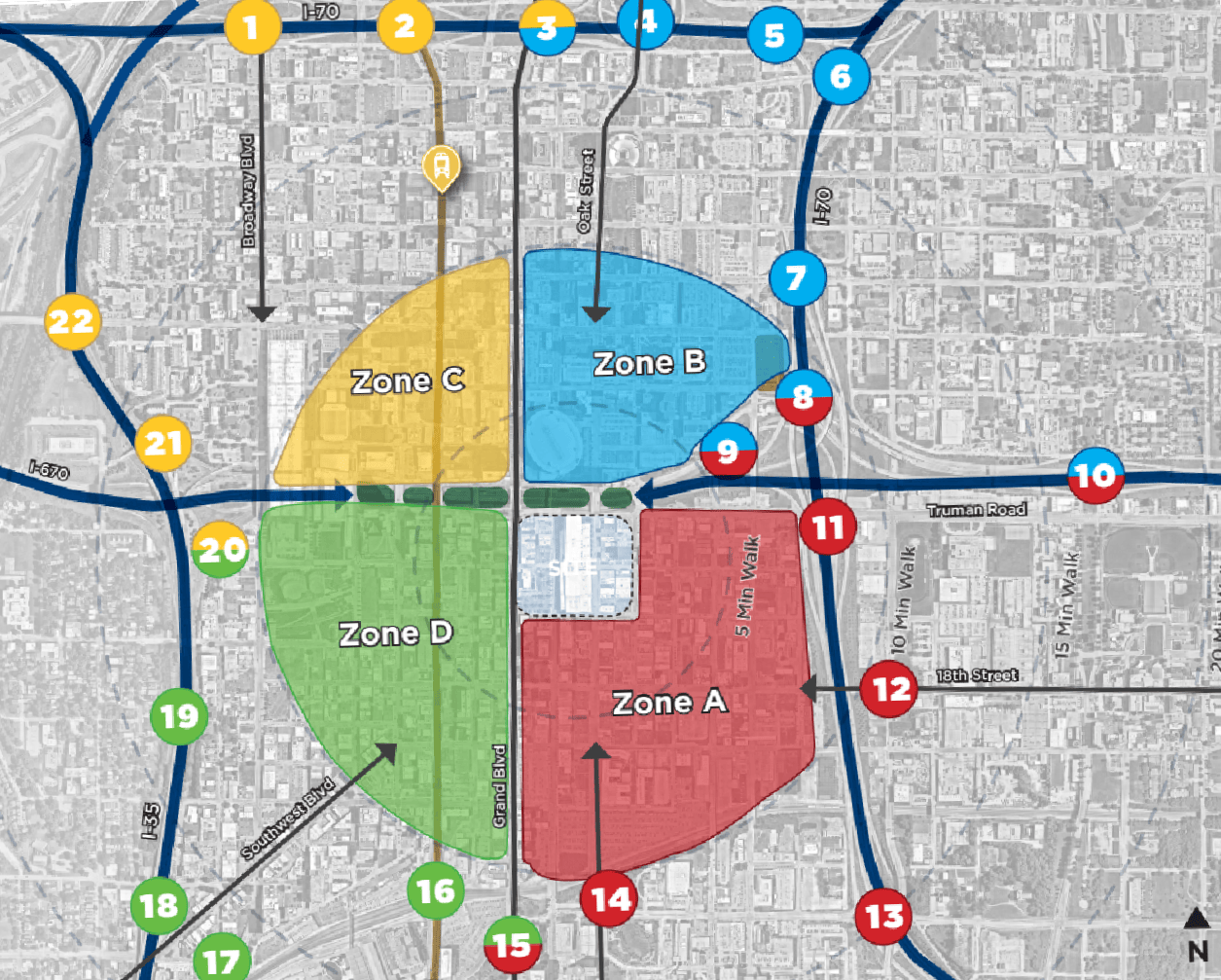
Saturday Night in the Crossroads
But for many owners of businesses already operating in the Crossroads, a more congested parking situation is just one more reason to oppose the downtown stadium.
On a recent Saturday night, cars slowly cruised along Oak, Locust and other streets, seeking an open slot amidst lines of cars parked bumper to bumper, parallel to the curbs. Surface lots are more common in this section of downtown with fewer large garages nearby.
To manage the parking with the addition of a downtown stadium, the Royals are pushing for an “integrated operations center,” like a hub to monitor area parking.
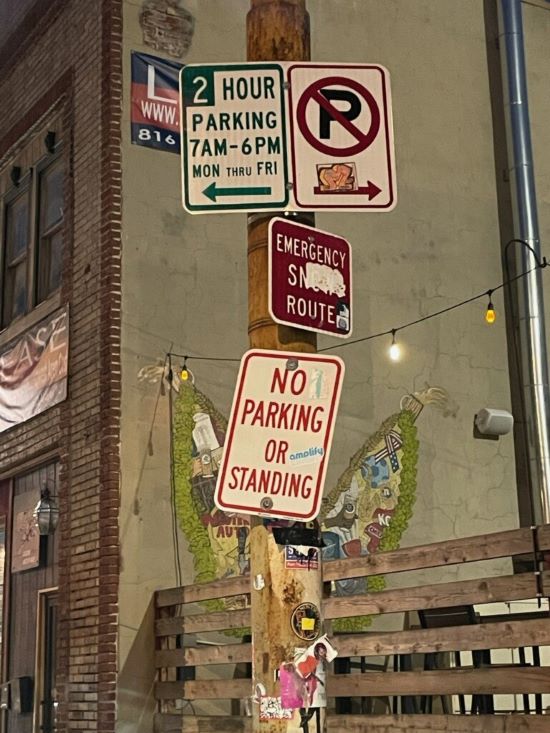
Such centers are used in other cities, like Minneapolis, another city where firm Kimley-Horn has helped manage parking challenges.
Kansas Citians who frequent downtown events are already familiar with using many of the methods suggested, such as buying parking ahead of time and using an app for payment.
T-Mobile Center, which offers almost no on-site parking, already uses a tiered system, color-coding locations.
Bob Kendrick, president of the Negro Leagues Baseball Museum, addressed the qualms that people are having about parking during an Instagram live conversation for Kansas City PBS’ “Flatland in Focus” program with host D. Rashaan Gilmore.
“We are creatures of habit, and we are creatures of comfort,” Kendrick said, noting that there might be some slight inconveniences as people adjust. “But there will be a place to park.”
Kendrick used the annual hot dog festival that brings thousands of people each year to the 18th and Vine area where the Negro Leagues Baseball Museum is located, as an example of what the city is capable of managing.
Further, he said, that the shift will encourage positive changes.
“I think this will trigger better public transportation,” he said. “We’ve seen this be successful in Atlanta, Denver and St. Louis.”
Change is Hard
Much also hinges on changing the attitudes and behavior of Kansas Citians, who live in a notably car-centric metropolitan area where convenient parking is widely considered a birth rite.
Greater Kansas City includes vast stretches of highway. With no lakes or mountains to rein us in, the area has developed with sprawling suburban areas across multiple counties.
Without mass transit on the level of the subway systems of larger cities, many people drive rather than using the bus or even car-pooling.
That’s a mindset transportation planners hope to change.
Getting people to accept that they will need to walk a bit to reach a venue will be an adjustment. Or possibly park and then ride the streetcar. Or take a bus.
Simply asking people to envision the ballpark downtown might be one crucial hurdle to clear.
More than a dozen U.S. cities have been revitalizing their downtowns in recent years and adding stadiums and arenas for professional teams.
Communities like Detroit, Columbus, Ohio, and Sacramento, California, are examples. The NBA’s Sacramento Kings once made Kansas City their home.
But people shouldn’t simply conjure plopping the suburban sea of parking found at Truman Sports Complex into the Crossroads.
The proposed new Royals ballpark will be smaller by about 4,000 seats. And 1,500 on-site parking spaces are included in the ballpark’s design.
Even some who support the idea of a downtown ballpark have chastised Royals management during meetings, pushing them to do a better job explaining how parking won’t be an issue.
Another question raised by some is who will serve as the enforcer for people who buy a parking spot ahead of time.
In enclosed garages, that issue can be managed by an attendant checking parking passes. But surface lots need a system of checking the cars parked there for extended periods of time.
James, the former mayor, has emphasized the human factor reflected in the grumbles about possible stadium parking woes. The Committee to Keep the Royals and Chiefs in Jackson County has paid Wickham James $70,000 for political strategy and consulting, according to a report filed with the Missouri Ethics Commission.
“People will learn and adjust,” he said. “But one thing that I know. People don’t like the way things are, but they absolutely hate change.”
Mary Sanchez is senior reporter for Kansas City PBS.





